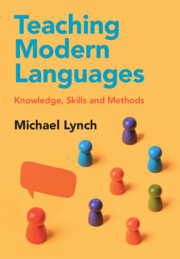Book contents
- Teaching Modern Languages
- Reviews
- Teaching Modern Languages
- Copyright page
- Dedication
- Contents
- Figures
- Tables
- 1 Introduction
- 2 Approaches to Language Teaching and Target Language Use
- 3 Skills Development
- 4 Modes of Teaching
- 5 Unit Planning
- 6 Lesson Planning
- 7 Differentiation and Responding to Pupils’ Needs
- 8 Assessment of, for and as Learning in Modern Foreign Languages
- 9 Digital Literacy
- 10 Remote Learning, Teaching and Assessment
- 11 Drama, Music and Games
- 12 Organisation and Management
- 13 Collaboration and Professional Development
- References
- Index
- References
4 - Modes of Teaching
Published online by Cambridge University Press: aN Invalid Date NaN
- Teaching Modern Languages
- Reviews
- Teaching Modern Languages
- Copyright page
- Dedication
- Contents
- Figures
- Tables
- 1 Introduction
- 2 Approaches to Language Teaching and Target Language Use
- 3 Skills Development
- 4 Modes of Teaching
- 5 Unit Planning
- 6 Lesson Planning
- 7 Differentiation and Responding to Pupils’ Needs
- 8 Assessment of, for and as Learning in Modern Foreign Languages
- 9 Digital Literacy
- 10 Remote Learning, Teaching and Assessment
- 11 Drama, Music and Games
- 12 Organisation and Management
- 13 Collaboration and Professional Development
- References
- Index
- References
Summary
Chapter 4 discusses the different modes of teaching that teachers can employ in class: direct, discussion, activity, enquiry, collaborative and group approaches are all examined in detail, with the advantages and disadvantages of each mode considered and practical advice given on when and where to employ them within a pupil-centred environment. The predominance of particular modes in class is examined, and the importance of teachers using a wide range is stressed, in addition to a discussion of what each mode is particularly suited to achieving. The chapter also examines Resource-Based Learning and Task Based Language Teaching in detail.
Keywords
Information
- Type
- Chapter
- Information
- Teaching Modern LanguagesKnowledge, Skills and Methods, pp. 59 - 75Publisher: Cambridge University PressPrint publication year: 2025
References
Further Reading
Accessibility standard: Inaccessible, or known limited accessibility
Content Navigation
Allows you to navigate directly to chapters, sections, or non‐text items through a linked table of contents, reducing the need for extensive scrolling.
Provides an interactive index, letting you go straight to where a term or subject appears in the text without manual searching.
Reading Order & Textual Equivalents
You will encounter all content (including footnotes, captions, etc.) in a clear, sequential flow, making it easier to follow with assistive tools like screen readers.
You get concise descriptions (for images, charts, or media clips), ensuring you do not miss crucial information when visual or audio elements are not accessible.
You get more than just short alt text: you have comprehensive text equivalents, transcripts, captions, or audio descriptions for substantial non‐text content, which is especially helpful for complex visuals or multimedia.
Visual Accessibility
You will still understand key ideas or prompts without relying solely on colour, which is especially helpful if you have colour vision deficiencies.
Structural and Technical Features
You gain clarity from ARIA (Accessible Rich Internet Applications) roles and attributes, as they help assistive technologies interpret how each part of the content functions.
